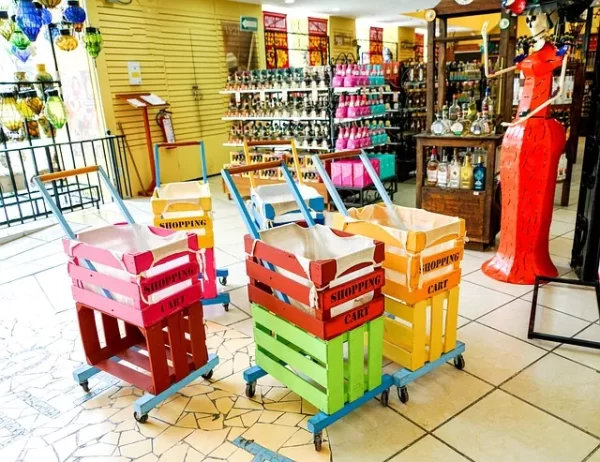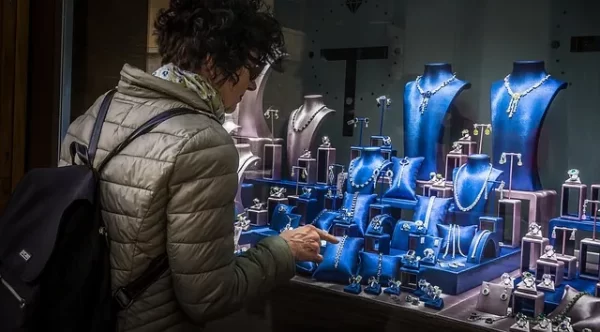
Discover the power of the Shop in Shop ideas of business model with our collection of success stories and ideas. From jewelry to terrariums, explore the innovative strategies and secrets of small businesses that have thrived by partnering with other retail stores. Learn about the pros and cons of this model, and get insights on how to start and grow your own business using this approach.
What is shop in shop business model?
“Shop in shop” typically refers to the practice of having a smaller retail space or “shop” located within a larger retail space or “shop”. This is often seen in department stores or shopping malls, where individual brands or businesses have their own designated areas within a larger space.
For example, a clothing brand might have a “shop” or section within a department store where they sell their products exclusively. This smaller shop within the larger store allows the brand to showcase their products and maintain their own distinct identity, while still benefiting from the foot traffic and exposure of the larger retail environment.
The concept of a “shop in shop” can also refer to pop-up shops or temporary retail spaces that are set up within an existing store. This allows brands or businesses to test out a new market or location without committing to a long-term lease or expensive storefront.
Few examples of successful shop in shop business models.
The concept of “shop in shop” is not attributed to any single individual or company as it has evolved over time as a response to changing consumer behaviors and retail trends.
However, the practice of having smaller retail spaces within a larger store can be traced back to the early department stores of the 19th century, such as Le Bon Marché in Paris and Macy’s in New York City. These early department stores had separate sections or “shops” for different product categories, such as clothing, housewares, and furniture.
Over time, the concept of “shop in shop” has been further refined and adapted to meet the needs of modern retailers and consumers. Today, it is a common strategy used by many retailers to offer a diverse range of products and experiences within a single retail environment.
There are many successful businesses that run on the “shop in shop” model. Here are a few examples:
Sephora: Sephora is a popular beauty retailer that operates within larger department stores such as JCPenney and Kohl’s. Sephora’s shops offer a wide selection of beauty products and have trained beauty advisors to assist customers.
Apple: Apple operates retail stores within larger shopping centers and malls. These Apple Stores offer a range of Apple products and accessories and provide customers with a unique and immersive shopping experience.
Nike: Nike operates its own standalone stores as well as shops within larger retailers such as Foot Locker and Dick’s Sporting Goods. Nike’s shops offer a wide range of Nike products and provide customers with a distinct brand experience.
Best Buy: Best Buy operates its own standalone stores as well as shops within larger retailers such as Target. Best Buy’s shops offer a range of electronics products and provide customers with expert advice and support.
Levi’s: Levi’s operates its own standalone stores as well as shops within larger retailers such as Macy’s. Levi’s shops offer a range of denim and apparel products and provide customers with a distinctive brand experience.

Shop in shop ideas: Success stories
Here is an example of a shop in shop ideas of business in the Indian market that collaborates with small to medium-sized businesses:
Case Study: Tjori
Tjori is an Indian online marketplace that offers a wide range of products such as clothing, jewelry, skincare, and home decor. Tjori has also collaborated with small to medium-sized businesses to create “shops on a shop” within their platform.
Tjori has created a platform that allows small businesses to create their own online storefronts within Tjori’s larger platform. The small businesses can then use Tjori’s marketing, logistics, and payment systems to sell their products.
Tjori also offers a range of services to help small businesses grow and succeed on their platform. They provide training on marketing, customer service, and operations, as well as assistance with product photography and listings.
By collaborating with small to medium-sized businesses, Tjori is able to offer a diverse range of products to their customers while also supporting local businesses. This strategy has helped Tjori to differentiate itself from other online marketplaces and has contributed to its success.
The “shop in shop” model has been particularly effective for Tjori in the Indian market, where small businesses play an important role in the economy. The collaboration with small to medium-sized businesses has allowed Tjori to offer a unique and diverse product range to customers while supporting local businesses and contributing to the growth of the Indian economy.
Here’s another example of a “shop in shop” business in the retail industry:
Case Study: Best Buy
Best Buy is a US-based electronics retailer that has implemented the “shop in shop” business model in many of its stores. Best Buy has partnered with other companies such as Apple, Samsung, and Microsoft to create branded shops within its stores.
For example, Best Buy has a dedicated Apple shop within many of its stores, where customers can find a wide range of Apple products such as iPhones, iPads, and Macs. Similarly, Best Buy has Samsung Experience shops, where customers can test out the latest Samsung products and get expert advice from Samsung specialists.
By partnering with other companies to create branded shops within its stores, Best Buy is able to offer customers a comprehensive range of products and services. The branded shops provide a unique and immersive shopping experience, allowing customers to explore and engage with products from their favorite brands.
Additionally, the “shop in shop” model allows Best Buy to benefit from the marketing and branding of the partner companies. For example, the Apple and Samsung shops within Best Buy stores feature the branding and design elements of those companies, which can help to attract customers and build brand recognition for Best Buy.
Overall, the “shop in shop” model has been successful for Best Buy, as it has helped them to differentiate themselves from competitors and offer a unique and immersive shopping experience for customers.

It can be your story too!
A young entrepreneur named Nisha who had a passion for jewelry. She had always dreamed of starting her own business and selling her unique collection of artificial jewelry.
One day, while browsing through a local market, Nisha noticed that there were not many stores selling specialty jewelry and the ones that did sell jewelry often had limited options. This sparked an idea in her mind – what if she could start her own portable jewelry units that could be easily set up in different locations around the city?
Nisha started doing research and realized that there was a growing trend of portable shops in the market. She decided to take advantage of this trend and start her own portable jewelry business.
Nisha’s plan was to create 10 small portable units, each measuring 10 square feet in size, that could be set up in different high-traffic areas around the city. These units would sell her specialty artificial jewelry and offer a unique shopping experience to customers.
To make her vision a reality, Nisha reached out to a team of designers and manufacturers to help create the portable units. The units were designed to be lightweight and easy to assemble, with a modern and elegant look that would attract customers.
Nisha carefully curated her collection of specialty jewelry, focusing on unique and high-quality pieces that would stand out in the market. She sourced her jewelry from local artisans and also collaborated with other designers to offer a diverse range of styles and designs.
Once the portable units were ready, Nisha began setting them up in different locations around the city. She chose high-traffic areas such as shopping malls, tourist spots, and public parks to attract a wide range of customers.
The response to Nisha’s portable jewelry units was overwhelming. Customers loved the unique shopping experience and the high-quality jewelry that Nisha offered. Many customers also appreciated the convenience of being able to shop for specialty jewelry in different locations around the city.
Nisha’s business grew rapidly, and she soon expanded to other cities and towns across the country. Her portable jewelry units became a popular destination for customers looking for unique and high-quality artificial jewelry.
In the end, Nisha’s passion for jewelry and her innovative business model helped her to create a successful and profitable business that offered a unique shopping experience to customers across the country.

Not convinced, here is another.
Priya, a young entrepreneur in her early 30s who has a passion for indoor plants. She always found joy in nurturing and growing plants, but she wanted to do something more with her passion. That’s when she came up with the idea of starting a shop in shop business model that sells terrariums with live indoor plants on them.
Priya’s terrarium designs were innovative and sleek, which immediately caught the attention of people. She started with just two locations in small malls and within a year had spread across the town, putting units in 25 malls. Her unique designs and high-quality terrariums became a hit with customers, and her business grew rapidly.
Initially, Priya started producing the terrariums from home, but once she put up her third unit, she realized the need for a dedicated space to produce more terrariums. She rented a space and started producing terrariums in larger quantities to meet the growing demand.
As her business continued to grow, Priya didn’t just stop with selling terrariums. She realized that there was an opportunity to offer additional services and generate extra revenue. That’s when she started offering terrarium placing services to corporate offices and other businesses. She would place her beautiful terrariums in lobbies, meeting rooms, or anywhere else her clients desired, adding a touch of greenery to their spaces.
Priya’s business continued to thrive, and she became a well-known name in the indoor plant and terrarium industry. Her innovative designs and unique business model made her stand out from the competition, and her dedication and hard work paid off in the end.
Today, Priya’s shop in shop business model has become a successful venture with a loyal customer base. Her passion for indoor plants and her entrepreneurial spirit has helped her to create a successful and profitable business, while also adding a touch of nature to people’s lives.
What made Priya success?
Let’s break down Priya’s business success secrets:
Out-of-the-box design: One of the main factors behind Priya’s success is her innovative and unique terrarium designs. She offers something different from what her competitors are offering, and this sets her apart from the crowd.
Low-cost setup: Priya’s business model is built on the shop in shop concept, where she operates portable units that take up minimal floor space. This not only allows her to keep her costs low but also gives her the flexibility to quickly move to new locations if needed.
Three-month trial period: Priya’s strategy of testing new locations for three months before committing to a long-term lease helps her to minimize risks and avoid costly mistakes. If a location doesn’t perform as expected, she can quickly move her unit to a new location.
Attractive on-shop merchandising: Priya’s terrariums are displayed attractively, which draws in customers and enhances the shopping experience. This helps to create a unique brand identity and encourages repeat customers.
Affordable pricing yet 75% gross margin: Priya’s pricing strategy is a major factor in her success. Despite offering unique and high-quality products, her prices are affordable, which attracts a wide range of customers. Additionally, she has managed to maintain a gross margin of 75%, which is an impressive figure for any business.
In summary, Priya’s business success can be attributed to her innovative designs, low-cost setup, careful location testing, attractive merchandising, and affordable pricing strategy. By focusing on these key factors, she has been able to create a successful and profitable business in the terrarium industry.
Some innovative shop in shop ideas you can try
Virtual Reality Experience Shops: These shops would be located within larger shopping centers and would offer customers a chance to experience immersive virtual reality (VR) games and experiences. Customers could purchase VR games and accessories within the shop.
Subscription Box Shops: These shops would offer customers a chance to purchase monthly subscription boxes from a variety of brands and product categories. The shop would showcase products from the subscription boxes and allow customers to try them out before purchasing.
Home Automation Shops: These shops would be located within larger home improvement stores and would offer customers a chance to purchase and install smart home automation products. The shop would showcase the latest home automation products and provide customers with expert advice and installation services.
Sustainable Living Shops: These shops would be located within larger department stores and would offer customers a chance to purchase sustainable and eco-friendly products. The shop would showcase products such as reusable bags, eco-friendly cleaning products, and sustainable clothing.
Health and Wellness Shops: These shops would be located within larger pharmacies and would offer customers a chance to purchase health and wellness products such as supplements, vitamins, and fitness equipment. The shop would provide customers with expert advice and consultations with nutritionists and personal trainers.
How to start a shop in shop business?
Selecting the perfect location for a “shop in shop” business unit is an important decision that can greatly impact the success of the business. Here are some key factors to consider when selecting a location:
Foot Traffic: Look for a location with high foot traffic, such as a shopping center or mall. A high volume of potential customers passing by can increase the chances of attracting new customers.
Target Market: Consider the demographics of the surrounding area and select a location that is likely to appeal to your target market. For example, a luxury clothing brand might want to locate its “shop in shop” within a high-end department store in an affluent neighborhood.
Competition: Be aware of nearby competitors and select a location that is not already saturated with similar businesses. Look for a location that offers a unique value proposition to customers that cannot be found elsewhere.
Accessibility: Make sure the location is easily accessible for customers, with ample parking and convenient public transportation options.
Cost: Consider the cost of renting the space and make sure it is within the budget of the business. Also, consider the potential return on investment and ensure that the cost of renting the space is justified by the potential revenue generated.
Starting a chain of shop in shop business.
Starting a chain of “shop in shop” business units can be a complex process, but here are some steps to guide you through the process:
Develop a Business Plan: Develop a detailed business plan that outlines your vision, goals, target market, competition, and financial projections. This will help you clarify your vision and ensure that you have a solid foundation for your business.
Identify Products or Services: Determine what products or services you want to offer in your “shop in shop” business. Consider your target market and identify what products or services are likely to appeal to them.
Research Potential Locations: Research potential locations for your business units. Look for high traffic areas that are accessible and convenient for your target market. Consider factors such as rent, competition, and accessibility.
Secure Partnerships: Establish partnerships with other businesses or brands that you want to feature in your business units. Negotiate deals that are mutually beneficial and provide value to your customers.
Design the Units: Design your business units to reflect the unique brand identity of each partner business while maintaining a cohesive overall aesthetic. Consider factors such as layout, signage, and product displays.
Hire Staff: Hire staff members who are knowledgeable about the products or services you offer and who can provide excellent customer service. Train them to provide a consistent brand experience across all business units.
Market Your Business: Develop a marketing strategy to promote your business units. Use a combination of traditional advertising methods and digital marketing tactics to reach your target market.
Monitor Performance: Monitor the performance of each business unit and make adjustments as needed to improve efficiency, customer satisfaction, and profitability.
Expand: Once your initial business units are established and profitable, consider expanding your chain to other locations. Use your experience and success to identify potential markets and continue to grow your business.
Advantages and disadvantages of shop in a shop business
Pros:
Cost-effective: Shop in shop business model allows businesses to share costs associated with rent, utilities, staffing, and other expenses, making it a cost-effective way to expand the business.
Variety for customers: Shop in shop business model allows customers to access multiple brands, products, and services in one location, which can provide a more comprehensive shopping experience.
Cross-promotion: Shop in shop business model allows for cross-promotion of brands and products, which can increase sales for all businesses involved.
Flexible: Shop in shop business model allows for more flexibility in terms of location, branding, and product offerings.
Cons:
Lack of Control: Shop in shop business model can limit the control a business has over its brand and products, as they are sharing space with other brands and products.
Conflicting Objectives: Shop in shop business model can create conflicting objectives among the different brands and products, which can result in disagreements and disputes.
Difficulties in Branding: Shop in shop business model can make it difficult for a brand to stand out and establish a unique brand identity, as it is sharing space with other brands.
Limited Space: Shop in shop business model can limit the amount of space available for each business, which can affect the ability to display products effectively and offer a good customer experience.